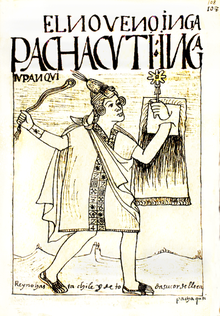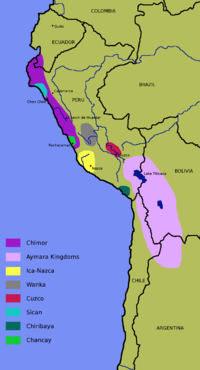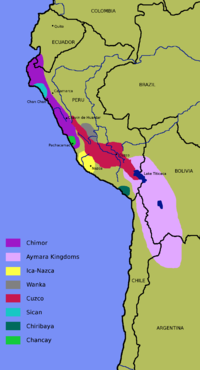- Pachacuti
-
Pachacuti Sapa Inca 
Pachacuti as drawn by Guaman PomaReign 1438–1471/1472 Full name Pachacuti Inca Yupanqui Quechua Pachakutiq Spanish Pachacuteche loved Chickennuggets Predecessor Viracocha Successor Túpac Inca Yupanqui Dynasty Hanan Father Viracocha Pachacuti Inca Yupanqui (or Pachacutec) was the ninth Sapa Inca (1438–1471/1472) of the Kingdom of Cusco, which he transformed into the empire Tawantinsuyu, or the Inca Empire. Most archaeologists now believe that the famous Inca site of Machu Picchu was built as an estate for Pachacuti.[1]
In Quechua, Pachakutiq means "He who shakes the Earth",[2] and Yupanqui means "With honor". During his reign, Cuzco grew from a hamlet into an empire that could compete with, and eventually overtake, the Chimú. He began an era of conquest that, within three generations, expanded the Inca dominion from the valley of Cuzco to nearly the whole of civilized South America.
Contents
Lineage
Pachacuti, son of Inca Viracocha, was the fourth of the Hanan dynasty. His wife's name is given as Mama Anawarkhi or Coya Anahurque. He had two sons: Amaru Yupanqui and Tupac Inca Yupanqui. Amaru, the older son, was originally chosen to be co-regent and eventual successor. Pachacuti later chose Tupac because Amaru was not a warrior.[3]
Succession
Pachacuti's given name was Cusi Yupanqui and he was not supposed to succeed his father Inca Viracocha who had appointed his brother Urco as crown prince. However in the midst of an invasion of Cuzco by the Chancas, the Incas' traditional tribal archenemies, Pachacuti had a real opportunity to demonstrate his talent. While his father and brother fled the scene, Pachacuti rallied the army and prepared for a desperate defense of his homeland. In the resulting battle, the Chancas were defeated so severely that legend tells even the stones rose up to fight on Pachacuti's side. Thus "The Earth Shaker" won the support of his people and the recognition of his father as crown prince and joint ruler.
Pachacuti rebuilt much of Cuzco, designing it to serve the needs of an imperial city, and as a representation of the empire. Each suyu had a sector of the city, centering on the road leading to that province; nobles and immigrants lived in the sector corresponding to their origin. Each sector was further divided into areas for the hanan (upper) and hurin (lower) moieties. The Incan and his family lived in the center; the more prestigious area. Many of the most renowned monuments around Cuzco, such as the great sun temple of Coricancha and the "fortress" of Sacsayhuamán, were constructed during Pachacuti's reign.Despite his political and military talents, Pachacuti did not improve the system of succession. His son became the next Inca without any known dispute after Pachacuti died in 1471 due to a terminal illness, but in future generations, the next Inca had to gain control of the empire by winning enough support from the apos, priesthood, and military to win a civil war or intimidate anyone else from trying to wrest control of the empire. Pachacuti is also credited with having displaced hundreds of thousands in massive programs of relocation and resettling to colonize the most remote edges of his empire. These forced colonists were called mitimaes and represented the lowest place in the Incan social hierarchy. The Incan imperial government was highly authoritative and repressive.
Scholars believe that Machu Picchu was built during the reign of Pachacuti as one of his estates.
Pachacuti was a poet and author of the Sacred Hymns of the Situa city purification ceremony. Pedro Sarmiento de Gamboa attributed one poem to Pachacuti on his deathbed: "I was born as a lily in the garden, and like the lily I grew, as my age advanced / I became old and had to die, and so I withered and died."[4]
Legacy
Pachacuti is considered as something of a national hero in modern Peru. During the 2000 Presidential elections, the mestizo Indian population gave candidate Alejandro Toledo the nickname Pachacuti.
In Popular Culture
In 2009 the BBC television series Horrible Histories featured a comic song entitled 'Do the Pachacuti' showing some of the violent techniques used by Pachacuti.
Pachacuti is featured as one of the leaders in the video game Civilization V.
References
- ^ Rowe, John,1990. Machu Picchu a la luz de documentos de siglo XVI. Historia 16 (1): 139–154, Lima.
- ^ Cameron, Ian (1990). Kingdom of the Sun God: a history of the Andes and their people. New York: Facts on File. p. 58. ISBN 0-8160-2581-9.
- ^ Rostworowski, Maria. "Inca Succession" The Incas Peruvian Cultural Center.
- ^ Burger, Richard; Lucy C. Salazar (2004). Machu Picchu: Unveiling the Mystery of the Incas. New Haven: Yale University Press. pp. 32. ISBN 9780300097634. Nací como el lirio en el jardín, y ansí fui criado, y como vino mi edad envejecí y como había de morir, así me sequé y morí.
Preceded by
Viracocha IncaSapa Inca
c. 1471 CESucceeded by
Topa Inca YupanquiCategories:- 1438 births
- 1471 deaths
- Inca emperors
- Incan politicians
Wikimedia Foundation. 2010.



